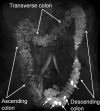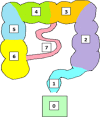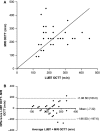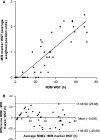Novel MRI tests of orocecal transit time and whole gut transit time: studies in normal subjects
- PMID: 24165044
- PMCID: PMC4285997
- DOI: 10.1111/nmo.12249
Novel MRI tests of orocecal transit time and whole gut transit time: studies in normal subjects
Abstract
Background: Colonic transit tests are used to manage patients with Functional Gastrointestinal Disorders. Some tests used expose patients to ionizing radiation. The aim of this study was to compare novel magnetic resonance imaging (MRI) tests for measuring orocecal transit time (OCTT) and whole gut transit time (WGT), which also provide data on colonic volumes.
Methods: 21 healthy volunteers participated. Study 1: OCTT was determined from the arrival of the head of a meal into the cecum using MRI and the Lactose Ureide breath test (LUBT), performed concurrently. Study 2: WGT was assessed using novel MRI marker capsules and radio-opaque markers (ROMs), taken on the same morning. Studies were repeated 1 week later.
Key results: OCTT measured using MRI and LUBT was 225 min (IQR 180-270) and 225 min (IQR 165-278), respectively, correlation r(s) = 0.28 (ns). WGT measured using MRI marker capsules and ROMs was 28 h (IQR 4-50) and 31 h ± 3 (SEM), respectively, correlation r(s) = 0.85 (p < 0.0001). Repeatability assessed using the intraclass correlation coefficient (ICC) was 0.45 (p = 0.017) and 0.35 (p = 0.058) for MRI and LUBT OCTT tests. Better repeatability was observed for the WGT tests, ICC being 0.61 for the MRI marker capsules (p = 0.001) and 0.69 for the ROM method (p < 0.001) respectively.
Conclusions & inferences: The MRI WGT method is simple, convenient, does not use X-ray and compares well with the widely used ROM method. Both OCTT measurements showed modest reproducibility and the MRI method showed modest inter-observer agreement.
Keywords: MRI; correlation; marker capsule; transit time.
© 2013 The Authors. Neurogastroenterology & Motility Published by John Wiley & Sons Ltd.
Figures






References
-
- Rao SS, Camilleri M, Hasler WL, et al. Evaluation of gastrointestinal transit in clinical practice: position paper of the American and European Neurogastroenterology and Motility Societies. Neurogastroenterol Motil. 2011;23:8–23. - PubMed
-
- Chang L, Drossman DA. Rome Foundation endpoints and outcomes conference 2009: optimising clinical trials in FGID. J Gastroenterol. 2010;105:722–30. - PubMed
-
- Metcalf AM, Phillips SF, Zinsmeister AR, MacCarty RL, Beart RW, Wolff BG. Simplified assessment of segmental colonic transit. Gastroenterology. 1987;92:40–7. - PubMed
Publication types
MeSH terms
Grants and funding
LinkOut - more resources
Full Text Sources
Other Literature Sources
Medical
Miscellaneous

